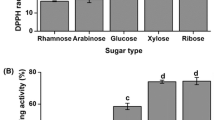Abstract
Gelatin extracted from the body wall of the sea cucumber (Stichopus japonicus) was hydrolyzed with flavourzyme. Low-molecular-weight gelatin hydrolysate (LMW-GH) of 700–1700 Da was produced using an ultrafiltration membrane bioreactor system. Chemiluminescence analysis revealed that LMW-GH scavenges high free radicals in a concentration-dependent manner; IC50 value for superoxide and hydroxyl radicals was 442 and 285 μg mL−1, respectively. LMW-GH exhibited excellent inhibitory characteristics against melanin synthesis and tyrosinase activity in B16 cells. Furthermore, LMW-GH notably increased intracellular glutathione (GSH), which in turn suppressed melanogenesis. LMW-GH performs antioxidation activity, holding the potential of being used as a valuable ingredient in function foods, cosmetics and pharmaceuticals or nutriceuticals.
Similar content being viewed by others
References
Aruoma, O. I., 1998. Free radicals oxidative stress, and antioxidants in human health and disease. J. Am. Oil Chem. Soc., 75: 199–211.
Aurand, L. W., Boonme, N. H., and Gidding G. G., 1977. Superoxide and singlet oxygen in milk lipid peroxidation. J. Dairy Sci., 60: 363–369.
Bradford, M. M., 1976. A rapid and sensitive method for the quantitiation of microgram quantities of protein utilizing the principle of protein-dye binding. Anal. Biochem., 72: 248–254.
Chen, H. M., Muramoto, K., and Yamauchi, F., 1995. Structural analysis of antioxidative peptides from soybean β-conglycinin. J. Agric. Food Chem., 43: 574–578.
Chen, H. M., Muramoto, K., Yamauchi, F., Fujimoto, K., and Nokihara, K., 1998. Antioxidative properties of histidine-containing peptides designed from peptide fragments found in the digests of a soybean protein. J. Agric. Food Chem., 46: 49–53.
Curto, E. V., Kwong, C., Hermersdörfer, H., Glatt, H., Santis, C., Virador, V., et al., 1999. Inhibitors of mammalian melanocyte tyrosinase: in vitro comparisons of alkyl esters of gentisic acid with other putative inhibitors. Biochem. Pharmacol., 57: 663–672.
Funasaka, Y., Komoto, M., and Ichihashi, M., 2000. Depigmenting effect of alpha-tocopheryl ferulate on normal human melanocytes. Pigment Cell Res., 8: 170–174.
Hearing, V. J., and Jiménez, M., 1989. Analysis of mammalian pigmentation at the molecular level. Pigment Cell Res., 2:75–85.
Hirata, T., Zaima, N., Yamashita, K., Ryoko, N., Xue, C. H., and Sugawara, T., 2005. Recent advances in researches on physiologically active substances in holothurians. J. Ocean Univ. Chin., 4(3): 193–197.
Iwata, M., Corn, T., Iwata, S., Everett, M. A., and Fuller, B. B., 1990. The relationship between tyrosinase activity and skin color in human foreskins. J. Invest. Dermatol., 95: 9–15.
Jamilan, B., and Harvinder, K. G., 2002. Properties of gelatins from skins of fish-black tilapia (Oreochromis mossambicus) and red tilapia (Oreochromis nilotica). Food Chem., 77:81–84.
Jara, J. R., Aroca, P., Solano, F., Martinez, J. H., and Lozano, J. A., 1988. The role of sulfhydryl compounds in mammalian melanogenesis: effect of cysteine and glutathione upon tyrosinase and the intermediates of the pathway. Biochim. Biophys. Acta, 967: 296–303.
Kim, S. K., Kim, Y. T., Byun, H. G., Nam, K. S., Joo, D. S., and Shahidi, F., 2001. Isolation and characterization of antioxidative peptides from gelatin hydrolysate of Alaska pollack skin. J. Agric. Food Chem., 49: 1984–1989.
Kim, Y. J., 2007. Antimelanogenic and antioxidant properties of gallic acid. Biol. Pharm. Bull., 30: 1052–1055.
Lin, L., and Li, B. F., 2006. Radical scavenging properties of protein hydrolysates from Jumbo flying squid (Dosidicus eschrichitii Steenstrup) skin gelatin. J. Sci. Food Agric., 14: 2290–2295.
Mendis, E., Rajapakse, N., and Kim, S. K., 2005. Antioxidant properties of a radical scavenging peptide purified from enzymatically prepared skin gelatin hydrolysate. J. Agric. Food Chem., 53: 581–587.
Mendis, E., Rajapakse, N., Byun, H. G., and Kim, S. K., 2005. Investigation of jumbo squid (Dosidicus gigas) skin gelatin peptides for their in vitro antioxidant effects. Life Sci., 77:2166–2178.
Prota, G., 1988. Progress in the chemistry of melanins and related metabolites. Med. Res. Rev., 8: 525–556.
Saito, M., Kunisaki, N., Urano, N., and Kimura, S., 2002. Collagen as the major edible component of sea cucumber (Stichopus japonicus). J. Food Sci., 4: 1319–1322.
Wang, J. F., Wang, Y., Zhao, L., Pang, L., and Xue, C. H., 2007. Effects of Apostichopus japonicus on antitumor and immune regulation in S180 bearing mice. Period. Ocean Univ. Chin., 37(1):93–96 (in Chinese with English abstract).
Wu, H. C., Chen, H. M., and Shiau, C. Y., 2003. Free amino acids and peptides as related to antioxidant properties protein hydrolysates of mackerel (Scomber australasicus). Food Res. Int., 36: 949–957.
Yamamura, T., Onishi, J., and Nishiyama, T., 2002. Antimelanogenic activity of hydrocoumarins in cultured normal human melanocytes by stimulating intracellular glutathione synthesis. Arch. Dermatol. Res., 294: 349–354.
Yang, J. I., Ho, H. Y., Chu, Y. J., and Chow, C. J., 2008. Characteristic and antioxidant activity of retorted gelatin hydrolysates from cobia (Rachycentron canadum) skin. Food Chem., 110: 128–136.
Zhao, X., Xue, C. H., and Li, B. F., 2008. Study of antioxidant activities of sulfated polysaccharides from Laminaria japonica. J. Appl. Phycol., 20: 431–436.
Zhao, Y. H., Li, B. F., Dong, S. Y., Zhao, X., and Zeng, M. Y., 2007. Antihypertensive effect and purification of an ACE inhibitory peptide from sea cucumber gelatin hydrolysate. Process Biochem., 42: 1586–1591.
Author information
Authors and Affiliations
Corresponding author
Rights and permissions
About this article
Cite this article
Wang, J., Wang, Y., Tang, Q. et al. Antioxidation activities of low-molecular-weight gelatin hydrolysate isolated from the sea cucumber Stichopus japonicus . J. Ocean Univ. China 9, 94–98 (2010). https://doi.org/10.1007/s11802-010-0094-9
Received:
Revised:
Accepted:
Published:
Issue Date:
DOI: https://doi.org/10.1007/s11802-010-0094-9




